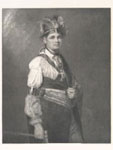The Fighting Canadiens

France supported the U.S. during the Revolutionary War. However, didn't they also back the Native Americans in Canada against the U.S.?
The Treaty of Paris, adopted at the end of the French and Indian War (1754-1763), transferred control of Canada from France to Britain. After the United States later declared independence from Britain, France began offering secret support to the Patriots in the forms of arms, ammunition, economic aid, and technical assistance. Although the French government did not support Native Americans against the United States, some of the French Canadians (Canadiens) who had remained in Canada after the British takeover fought alongside Native American allies against the Patriots.
After acquiring Canada, the British had treated the Canadiens mildly. They allowed the former French citizens to continue practicing their Roman Catholic religion, and although the British required all residents of Canada to use the common law for public and criminal issues, they retained French civil law for private legal matters.
These measures helped the British to win the loyalty of many French Canadians. At the beginning of the Revolution, an American raid on Fort St. Jean, not far from Montreal, alarmed British officials and turned some Montreal residents against the Patriots. America’s wartime exclusion from the British fur trade benefited Montreal merchants, and despite lingering resentment over Britain’s possession of their colony, they decided that their own business interests lay with the preservation of British ties. Other French Canadians followed their religious and political leaders to the British side. Americans, after all, were the same people the Canadiens had just fought in the French and Indian War, when British New Englanders committed such atrocities as seizing farms, livestock, and produce, and stabling horses in their Catholic churches. Canadiens believed that they were better off with the British conquerors than with the American Revolutionaries.
In the territory bordering Canada and the new United States, the Six Nations of the Iroquois were also forced to make decisions with regard to alliances. Although many preferred to remain neutral, Tuscaroras and Oneidas generally chose to ally with the Americans. The rest of the Six Nations, led by the Mohawks, supported the British. Molly Brant, a respected Mohawk and mistress to British Indian Superintendent Sir William Johnson, and her brother Mohawk war chief Joseph Brant (Thayendanegea), convinced the Mohawk to side with the British. In several battles, Iroquois warriors, British regulars, and Canadien militia fought together to retain control over territory far down into Ohio Country and into the area around present-day Detroit.
Although some Canadiens fought with the British, others fought with the Patriots. For example, the 1st Canadian Regiment included Canadiens sympathetic to the American cause. They saw action in the Battles of Quebec (1775), Trois-Rivieres (1776), and Saratoga (1777), among others.
Middlekauff, Robert. The Glorious Cause: The American Revolution, 1763-1789. New York: Oxford University Press, 1982.
Taylor, Alan. The Divided Ground: Indians, Settlers, and the Northern Borderland in the American Revolution. New York: Alfred A. Knopf, 2006.
Calloway, Colin G. The American Revolution in Indian Country. Cambridge: Cambridge University Press, 1995.
Graymont, Barbara. The Iroquois in the American Revolution. Syracuse: Syracuse University Press, 1972.
Lawson, Phillip. The Imperial Challenge: Quebec and Britain in the Age of the American Revolution. Montreal: McGill-Queens University Press, 1994.
Stanley, George. Canada Invaded, 1775-1776. Toronto: Hakkert Press, 1973.